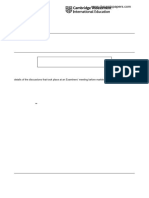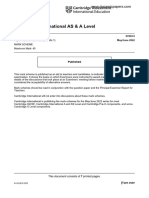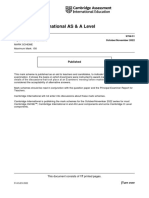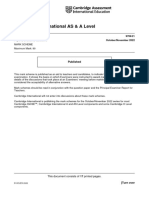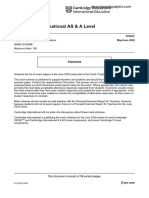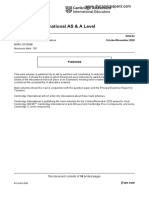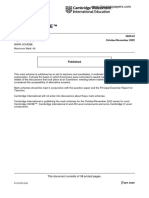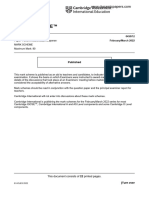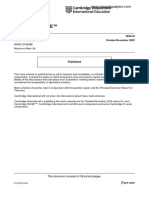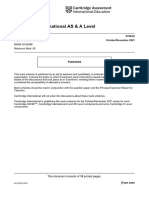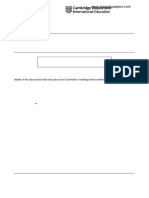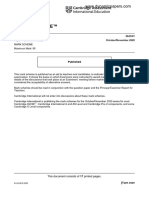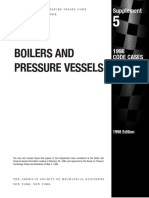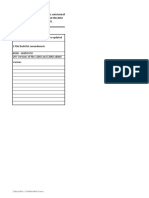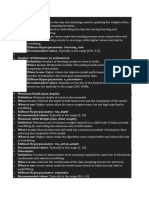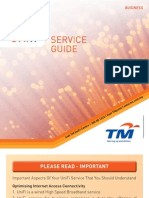9700_w22_ms_31
9700_w22_ms_31
Uploaded by
alashigidi123Copyright:
Available Formats
9700_w22_ms_31
9700_w22_ms_31
Uploaded by
alashigidi123Copyright
Available Formats
Share this document
Did you find this document useful?
Is this content inappropriate?
Copyright:
Available Formats
9700_w22_ms_31
9700_w22_ms_31
Uploaded by
alashigidi123Copyright:
Available Formats
www.dynamicpapers.
com
Cambridge International AS & A Level
BIOLOGY 9700/31
Paper 3 Advanced Practical Skills 1 October/November 2022
MARK SCHEME
Maximum Mark: 40
Published
This mark scheme is published as an aid to teachers and candidates, to indicate the requirements of the
examination. It shows the basis on which Examiners were instructed to award marks. It does not indicate the
details of the discussions that took place at an Examiners’ meeting before marking began, which would have
considered the acceptability of alternative answers.
Mark schemes should be read in conjunction with the question paper and the Principal Examiner Report for
Teachers.
Cambridge International will not enter into discussions about these mark schemes.
Cambridge International is publishing the mark schemes for the October/November 2022 series for most
Cambridge IGCSE™, Cambridge International A and AS Level components and some Cambridge O Level
components.
This document consists of 7 printed pages.
© UCLES 2022 [Turn over
9700/31 Cambridge International AS & A Level – Mark Scheme www.dynamicpapers.com
October/November 2022
PUBLISHED
Generic Marking Principles
These general marking principles must be applied by all examiners when marking candidate answers. They should be applied alongside the
specific content of the mark scheme or generic level descriptors for a question. Each question paper and mark scheme will also comply with these
marking principles.
GENERIC MARKING PRINCIPLE 1:
Marks must be awarded in line with:
• the specific content of the mark scheme or the generic level descriptors for the question
• the specific skills defined in the mark scheme or in the generic level descriptors for the question
• the standard of response required by a candidate as exemplified by the standardisation scripts.
GENERIC MARKING PRINCIPLE 2:
Marks awarded are always whole marks (not half marks, or other fractions).
GENERIC MARKING PRINCIPLE 3:
Marks must be awarded positively:
• marks are awarded for correct/valid answers, as defined in the mark scheme. However, credit is given for valid answers which go beyond the
scope of the syllabus and mark scheme, referring to your Team Leader as appropriate
• marks are awarded when candidates clearly demonstrate what they know and can do
• marks are not deducted for errors
• marks are not deducted for omissions
• answers should only be judged on the quality of spelling, punctuation and grammar when these features are specifically assessed by the
question as indicated by the mark scheme. The meaning, however, should be unambiguous.
GENERIC MARKING PRINCIPLE 4:
Rules must be applied consistently, e.g. in situations where candidates have not followed instructions or in the application of generic level
descriptors.
© UCLES 2022 Page 2 of 7
9700/31 Cambridge International AS & A Level – Mark Scheme www.dynamicpapers.com
October/November 2022
PUBLISHED
GENERIC MARKING PRINCIPLE 5:
Marks should be awarded using the full range of marks defined in the mark scheme for the question (however; the use of the full mark range may
be limited according to the quality of the candidate responses seen).
GENERIC MARKING PRINCIPLE 6:
Marks awarded are based solely on the requirements as defined in the mark scheme. Marks should not be awarded with grade thresholds or
grade descriptors in mind.
Science-Specific Marking Principles
1 Examiners should consider the context and scientific use of any keywords when awarding marks. Although keywords may be present, marks
should not be awarded if the keywords are used incorrectly.
2 The examiner should not choose between contradictory statements given in the same question part, and credit should not be awarded for
any correct statement that is contradicted within the same question part. Wrong science that is irrelevant to the question should be ignored.
3 Although spellings do not have to be correct, spellings of syllabus terms must allow for clear and unambiguous separation from other
syllabus terms with which they may be confused (e.g. ethane / ethene, glucagon / glycogen, refraction / reflection).
4 The error carried forward (ecf) principle should be applied, where appropriate. If an incorrect answer is subsequently used in a scientifically
correct way, the candidate should be awarded these subsequent marking points. Further guidance will be included in the mark scheme
where necessary and any exceptions to this general principle will be noted.
5 ‘List rule’ guidance
For questions that require n responses (e.g. State two reasons …):
• The response should be read as continuous prose, even when numbered answer spaces are provided.
• Any response marked ignore in the mark scheme should not count towards n.
• Incorrect responses should not be awarded credit but will still count towards n.
• Read the entire response to check for any responses that contradict those that would otherwise be credited. Credit should not be
awarded for any responses that are contradicted within the rest of the response. Where two responses contradict one another, this
should be treated as a single incorrect response.
• Non-contradictory responses after the first n responses may be ignored even if they include incorrect science.
© UCLES 2022 Page 3 of 7
9700/31 Cambridge International AS & A Level – Mark Scheme www.dynamicpapers.com
October/November 2022
PUBLISHED
6 Calculation specific guidance
Correct answers to calculations should be given full credit even if there is no working or incorrect working, unless the question states ‘show
your working’.
For questions in which the number of significant figures required is not stated, credit should be awarded for correct answers when rounded
by the examiner to the number of significant figures given in the mark scheme. This may not apply to measured values.
For answers given in standard form (e.g. a 10n) in which the convention of restricting the value of the coefficient (a) to a value between 1
and 10 is not followed, credit may still be awarded if the answer can be converted to the answer given in the mark scheme.
Unless a separate mark is given for a unit, a missing or incorrect unit will normally mean that the final calculation mark is not awarded.
Exceptions to this general principle will be noted in the mark scheme.
7 Guidance for chemical equations
Multiples / fractions of coefficients used in chemical equations are acceptable unless stated otherwise in the mark scheme.
State symbols given in an equation should be ignored unless asked for in the question or stated otherwise in the mark scheme.
Mark scheme abbreviations:
; separates marking points
/ alternative answers for the same marking point
R reject
A accept
I ignore
AVP any valid point
AW alternative wording (where responses vary more than usual)
ecf error carried forward
underline actual word underlined must be used by candidate (grammatical variants accepted)
max indicates the maximum number of marks that can be given
ora or reverse argument
© UCLES 2022 Page 4 of 7
9700/31 Cambridge International AS & A Level – Mark Scheme www.dynamicpapers.com
October/November 2022
PUBLISHED
Question Answer Marks
1(a)(i) 1 volume of water stated between 15 and 30 cm3 ; 1
1(a)(ii) 1 shows three other concentrations of ascorbic acid and in descending order ; 2
2 correct volumes of ascorbic acid and water to make 20 cm3 and correct concentration ;
1(a)(iii) 1 heading for independent variable: concentration of ascorbic acid and g dm–3 ; 5
2 heading dependent variable: volume and iodine and cm3 ;
3 results for all concentrations ;
4 greatest volume of iodine for highest concentration of ascorbic acid ;
5 records results to appropriate accuracy ;
1(a)(iv) 1 volume of iodine added and cm3 ; 1
1(a)(v) 1 correct estimation of concentration of ascorbic acid ; 1
1(a)(vi) 1 shows division by, time / 15 (minutes) ; 2
2 (correct) answer and units g dm–3 min–1 ;
1(a)(vii) any two from: 2
1 difficult to read scale on syringe ;
2 lack of suitable precision / ref. to volume of drop being too large ;
3 difficult to judge end-point / imprecise end-point (because whole drops are added each time) ;
4 imprecise start time (depending on when dialysis tubing added to distilled water) ;
5 rate of diffusion changes with time (highest at start and decreases as concentration gradient decreases) ;
6 volume of water added to outside of dialysis tubing not precisely determined so experiment could not be reliably
repeated ;
1(a)(viii) any two from: 2
1 repeat and find mean ;
2 use of, burette / syringe, with narrow divisions ;
3 colorimeter / colour chart / colour standard, for end-point ;
4 use white card behind tube ;
5 find mass of iodine added ;
© UCLES 2022 Page 5 of 7
9700/31 Cambridge International AS & A Level – Mark Scheme www.dynamicpapers.com
October/November 2022
PUBLISHED
Question Answer Marks
1(b)(i) 1 x-axis: time / hours 4
and
y-axis: water content / g of water for each g of melon ;
2 scale on x-axis: 2 hour to 2 cm, labelled every 2 cm
and
scale on y-axis: 0.2 g to 2 cm, labelled every 2 cm ;
3 correct plotting of six points using small crosses or dots in circles ;
4 at least five plots joined with a thin line passing through all points ;
1(b)(ii) 1 no net movement of water in or out of fruit ; 2
2 ref. to equal, water / solute, potential / AW ;
© UCLES 2022 Page 6 of 7
9700/31 Cambridge International AS & A Level – Mark Scheme www.dynamicpapers.com
October/November 2022
PUBLISHED
Question Answer Marks
2(a)(i) 1 minimum size and number of tissue layers ; 5
2 draws the correct region of the stem and no cells ;
3 vascular bundle subdivided ;
4 correct size of vascular bundle relative to other layers of tissue;
5 label line and label to epidermis ;
2(a)(ii) 1 minimum size and lines continuous, thin and sharp and no shading ; 5
2 draws only four whole vessel elements and each touches at least one other ;
3 two lines around each vessel element and three lines where vessel elements touch ;
4 vessel elements angular ;
5 label line and label to one vessel element wall ;
2(b)(i) 1 correct measurement of scale bar and length of trichome (X –Y) ; 3
2 correct calculation e.g. shows length of scale bar divided by 100 and divided by 0.16 ;
3 correct answer and units ;
2(b)(ii) label line to one stoma ; 1
2(b)(iii) 1 table with headings for Fig. 2.2 and Fig. 2.3 and table organised to show a similarity and differences ; 4
2 two correct differences ;;
any two from:
feature Fig. 2.2 Fig. 2.3
segments fewer more ;
structure at tip of trichome more / larger fewer / smaller ;
base of trichome present absent ;
width thin thick ;
3 similarity: e.g. wider at base than at tip ;
© UCLES 2022 Page 7 of 7
You might also like
- ISO 6888-1 Second Edition 2021-08Document28 pagesISO 6888-1 Second Edition 2021-08Coper CPerú100% (1)
- Golden Dawn - The Invoking Pentagram Ritual of AirDocument2 pagesGolden Dawn - The Invoking Pentagram Ritual of AirmoczydlowskiNo ratings yet
- Native American FolktalesDocument37 pagesNative American FolktalesMySecret GardenmdpNo ratings yet
- 9700_w22_ms_33Document6 pages9700_w22_ms_33alashigidi123No ratings yet
- Cambridge International AS & A Level: Biology 9700/33 May/June 2022Document7 pagesCambridge International AS & A Level: Biology 9700/33 May/June 2022alashigidi123No ratings yet
- Cambridge International AS & A Level: Biology 9700/22 February/March 2022Document13 pagesCambridge International AS & A Level: Biology 9700/22 February/March 2022Abdelrhmanf403No ratings yet
- Cambridge International AS & A Level: EconomicsDocument15 pagesCambridge International AS & A Level: EconomicsAndrew BadgerNo ratings yet
- Get PaperDocument7 pagesGet PaperXabso ShaafiNo ratings yet
- Cambridge International AS & A Level: Accounting 9706/31 October/November 2022Document17 pagesCambridge International AS & A Level: Accounting 9706/31 October/November 2022ryan valtrainNo ratings yet
- Cambridge International AS & A Level: Accounting 9706/32 October/November 2022Document22 pagesCambridge International AS & A Level: Accounting 9706/32 October/November 2022alanmuchenjeNo ratings yet
- Cambridge International AS & A Level: Accounting 9706/21 October/November 2022Document17 pagesCambridge International AS & A Level: Accounting 9706/21 October/November 2022damiangoromonziiNo ratings yet
- Cambridge International AS & A Level: Physics 9702/41 May/June 2020Document19 pagesCambridge International AS & A Level: Physics 9702/41 May/June 2020pvaidehi9826No ratings yet
- Cambridge International AS & A Level: Physics 9702/43 October/November 2021Document15 pagesCambridge International AS & A Level: Physics 9702/43 October/November 2021pvaidehi9826No ratings yet
- Cambridge International AS & A Level: Biology 9700/34 May/June 2022Document8 pagesCambridge International AS & A Level: Biology 9700/34 May/June 2022mariakhan.educationNo ratings yet
- Cambridge International AS & A Level: Economics 9708/23 October/November 2022Document15 pagesCambridge International AS & A Level: Economics 9708/23 October/November 2022Andrew BadgerNo ratings yet
- Cambridge O Level: Travel & Tourism 7096/13 October/November 2022Document12 pagesCambridge O Level: Travel & Tourism 7096/13 October/November 2022ranveergour24No ratings yet
- Cambridge International AS & A Level: Biology 9700/42 March 2020Document23 pagesCambridge International AS & A Level: Biology 9700/42 March 2020Y. PurwandariNo ratings yet
- Cambridge International AS & A Level: Physics 9702/42 October/November 2020Document16 pagesCambridge International AS & A Level: Physics 9702/42 October/November 2020zavar aliNo ratings yet
- Cambridge International AS & A Level: Physics 9702/31 May/June 2021Document8 pagesCambridge International AS & A Level: Physics 9702/31 May/June 2021SaimaNo ratings yet
- Cambridge O Level: Biology 5090/62 October/November 2022Document9 pagesCambridge O Level: Biology 5090/62 October/November 2022Ateeb MahmoodNo ratings yet
- Cambridge IGCSE ™: Physics 0625/41 October/November 2022Document16 pagesCambridge IGCSE ™: Physics 0625/41 October/November 2022Syed Tanveer MahtabNo ratings yet
- Cambridge IGCSE ™: Biology 0610/42 October/November 2022Document15 pagesCambridge IGCSE ™: Biology 0610/42 October/November 2022Rita SmairatNo ratings yet
- Tntms PDFDocument12 pagesTntms PDFzaifa shaNo ratings yet
- Cambridge International AS & A Level: Biology 9700/33 October/November 2022Document6 pagesCambridge International AS & A Level: Biology 9700/33 October/November 2022mariakhan.educationNo ratings yet
- Cambridge International AS & A Level: Accounting 9706/32 May/June 2022Document19 pagesCambridge International AS & A Level: Accounting 9706/32 May/June 2022Aydin Rahman6666No ratings yet
- Cambridge IGCSE™: Biology 0610/62 March 2022Document7 pagesCambridge IGCSE™: Biology 0610/62 March 2022tkmuhzin9No ratings yet
- Cambridge International AS & A Level: Business 9609/13 October/November 2022Document19 pagesCambridge International AS & A Level: Business 9609/13 October/November 2022Sasa DzudzevicNo ratings yet
- Cambridge IGCSE ™: Chemistry 0620/42 October/November 2022Document10 pagesCambridge IGCSE ™: Chemistry 0620/42 October/November 2022baysanamir70No ratings yet
- 0610_w22_ms_43Document13 pages0610_w22_ms_43Kritansh ShingadiaNo ratings yet
- 56 PDFDocument15 pages56 PDFpp baibeNo ratings yet
- Cambridge International AS & A Level: Chemsitry 9701/33 May/June 2022Document10 pagesCambridge International AS & A Level: Chemsitry 9701/33 May/June 2022Masoud AliNo ratings yet
- Cambridge International AS & A Level: Economics 9708/22 February/March 2022Document12 pagesCambridge International AS & A Level: Economics 9708/22 February/March 2022Andrew BadgerNo ratings yet
- Cambridge International AS Level: Environmental Management 8291/11 October/November 2022Document18 pagesCambridge International AS Level: Environmental Management 8291/11 October/November 2022Spencer HastingsNo ratings yet
- Cambridge IGCSE ™: Biology 0610/62 October/November 2022Document10 pagesCambridge IGCSE ™: Biology 0610/62 October/November 2022vanshrajsinh9No ratings yet
- Cambridge IGCSE ™: Biology 0610/62 October/November 2022Document10 pagesCambridge IGCSE ™: Biology 0610/62 October/November 2022ramloghun veerNo ratings yet
- s25Document22 pagess25ranat.2027No ratings yet
- Cambridge IGCSE ™: Physics 0625/42 October/November 2022Document15 pagesCambridge IGCSE ™: Physics 0625/42 October/November 2022snehakewlani25No ratings yet
- November 2022 (v3) MSDocument15 pagesNovember 2022 (v3) MSnicoleshambare84No ratings yet
- Cambridge International AS & A Level: Accounting 9706/22 October/November 2021Document15 pagesCambridge International AS & A Level: Accounting 9706/22 October/November 2021Vernan ZivanaiNo ratings yet
- Cambridge International AS & A Level: Business 9609/22 October/November 2022Document24 pagesCambridge International AS & A Level: Business 9609/22 October/November 2022aromajaryanNo ratings yet
- Travel Past PaperDocument23 pagesTravel Past Paperruggiet87No ratings yet
- Cambridge International AS & A Level: Physics 9702/43 May/June 2021Document18 pagesCambridge International AS & A Level: Physics 9702/43 May/June 2021pvaidehi9826No ratings yet
- Cambridge International AS & A Level: Biology 9700/34 October/November 2021Document8 pagesCambridge International AS & A Level: Biology 9700/34 October/November 2021lllllisaNo ratings yet
- Cambridge International AS & A Level: Biology 9700/32 May/June 2020Document9 pagesCambridge International AS & A Level: Biology 9700/32 May/June 2020rohanuday3No ratings yet
- Cambridge IGCSE™: Biology 0610/42 February/March 2022Document12 pagesCambridge IGCSE™: Biology 0610/42 February/March 2022pp baibeNo ratings yet
- 9702 w22 Ms 43 PDFDocument15 pages9702 w22 Ms 43 PDFsangdeepNo ratings yet
- Cambridge International AS & A Level: Biology 9700/33Document7 pagesCambridge International AS & A Level: Biology 9700/33alashigidi123No ratings yet
- Cambridge IGCSE ™: Physics 0625/62 October/November 2022Document9 pagesCambridge IGCSE ™: Physics 0625/62 October/November 2022Ar Ar ViNo ratings yet
- 100 9njkkmkDocument8 pages100 9njkkmkjanaabuswayNo ratings yet
- Cambridge IGCSE ™: Physics 0625/63 October/November 2022Document8 pagesCambridge IGCSE ™: Physics 0625/63 October/November 2022Ar Ar ViNo ratings yet
- Cambridge International AS & A Level: Economics 9708/22 October/November 2022Document17 pagesCambridge International AS & A Level: Economics 9708/22 October/November 2022kutsofatsoNo ratings yet
- Cambridge O Level: Accounting 7707/23 October/November 2022Document18 pagesCambridge O Level: Accounting 7707/23 October/November 2022FahadNo ratings yet
- Cambridge IGCSE ™: Physics 0625/43 October/November 2022Document16 pagesCambridge IGCSE ™: Physics 0625/43 October/November 2022azimagiccookieNo ratings yet
- Cambridge International AS & A Level: Biology 9700/33 May/June 2020Document9 pagesCambridge International AS & A Level: Biology 9700/33 May/June 2020donald kazaNo ratings yet
- Cambridge International A Level: Mathematics 9709/33 October/November 2022Document15 pagesCambridge International A Level: Mathematics 9709/33 October/November 2022Muhammad RidzwanNo ratings yet
- Cambridge International AS & A Level: Accounting 9706/32 March 2021Document19 pagesCambridge International AS & A Level: Accounting 9706/32 March 2021Ahmed NaserNo ratings yet
- Cambridge International AS & A Level: Biology 9700/43 May/June 2022Document23 pagesCambridge International AS & A Level: Biology 9700/43 May/June 2022Aneeqa KhanNo ratings yet
- Cambridge International AS & A Level: Biology 9700/35 October/November 2021Document8 pagesCambridge International AS & A Level: Biology 9700/35 October/November 2021lllllisaNo ratings yet
- Cambridge International AS & A Level: Biology 9700/32Document8 pagesCambridge International AS & A Level: Biology 9700/32alashigidi123No ratings yet
- Cambridge IGCSE™: Physics 0625/41 October/November 2020Document17 pagesCambridge IGCSE™: Physics 0625/41 October/November 2020Stargazing X CjNo ratings yet
- Cambridge International AS & A Level: Physics 9702/34 May/June 2020Document9 pagesCambridge International AS & A Level: Physics 9702/34 May/June 2020Arthur WirjoNo ratings yet
- Cambridge International AS & A Level: Economics 9708/22Document20 pagesCambridge International AS & A Level: Economics 9708/22rose williamsNo ratings yet
- Europes Automotive Industry On The Move Competitiveness in A Changing World, Vol.32 PDFDocument280 pagesEuropes Automotive Industry On The Move Competitiveness in A Changing World, Vol.32 PDFAlan WeissNo ratings yet
- BPVC Code Cases 5 PDFDocument54 pagesBPVC Code Cases 5 PDFEymenNo ratings yet
- D&D Adventurers League Adaptation Guides v2.4Document67 pagesD&D Adventurers League Adaptation Guides v2.4Payton ElliottNo ratings yet
- All Demo and ScriptsDocument21 pagesAll Demo and ScriptsKaren CariñoNo ratings yet
- Acrylamide CGP Fact SheetDocument4 pagesAcrylamide CGP Fact Sheetapi-301591849No ratings yet
- PS 4 MorettiDocument17 pagesPS 4 MorettiНикита КрасуляNo ratings yet
- AAS and ICP Determination of Heavy Metal ContentDocument15 pagesAAS and ICP Determination of Heavy Metal ContentMentewab Ethiopia100% (1)
- (1900) The Game Birds and Wild Fowl of The British IslesDocument594 pages(1900) The Game Birds and Wild Fowl of The British IslesHerbert Hillary Booker 2nd100% (2)
- En Barozzi-Veiga Portfolio-2019Document13 pagesEn Barozzi-Veiga Portfolio-2019Aaron Hong Wan ChanNo ratings yet
- Question Bank On HHP LocosDocument76 pagesQuestion Bank On HHP LocosTikam Chauhan82% (11)
- EP SPS 400 5000 SeriesDocument172 pagesEP SPS 400 5000 SeriesHakim GOURAIANo ratings yet
- GOM Hyperion AviationDocument403 pagesGOM Hyperion AviationSHERIEFNo ratings yet
- Cold Drawing Process - A Review: January 2013Document8 pagesCold Drawing Process - A Review: January 2013mohdfirdausNo ratings yet
- Extensor Tendon Injury ProtocolDocument11 pagesExtensor Tendon Injury ProtocoltasneempichoriNo ratings yet
- Excessive Black SmokeDocument2 pagesExcessive Black SmokeDaniel TekleNo ratings yet
- PDF Coming Sunday Notes F 1.1 Book Philosophical Bases of Education Unit II Part A and BDocument12 pagesPDF Coming Sunday Notes F 1.1 Book Philosophical Bases of Education Unit II Part A and BHARISH100% (1)
- Hematology Act.1 FinalsDocument2 pagesHematology Act.1 FinalsUB Accounts and ManagementNo ratings yet
- Hitachi PXR-D Instruction ManualDocument319 pagesHitachi PXR-D Instruction ManualJamesNo ratings yet
- Af116b 30 22RT 13Document5 pagesAf116b 30 22RT 13AdelAlcebaiNo ratings yet
- Gating ManualDocument10 pagesGating ManualKeyur BabariaNo ratings yet
- Learning Rate (Or Eta)Document2 pagesLearning Rate (Or Eta)anuragpanda222No ratings yet
- Sist en Iso 6507 1 2018Document13 pagesSist en Iso 6507 1 2018Rui CalhauNo ratings yet
- A Very Special All-Inclusive Custom-Designed Tour Hosted by Dick West and Stephen WestonDocument16 pagesA Very Special All-Inclusive Custom-Designed Tour Hosted by Dick West and Stephen Westonmarym_novakbeattyNo ratings yet
- Ideapad320-15isk 320x-15isk 320-15ikb 320x-15ikb 320-15ikbtouch HMM 201704Document84 pagesIdeapad320-15isk 320x-15isk 320-15ikb 320x-15ikb 320-15ikbtouch HMM 201704MarcoNo ratings yet
- ParagraphDocument2 pagesParagraphAninditaElfaNo ratings yet
- TM Unifi BIZ - BI - Service Guide - v3.4Document41 pagesTM Unifi BIZ - BI - Service Guide - v3.4Wan Mohd ThariqNo ratings yet
- Areas of Triangles, Parallelograms, Sectors and Segments Area of TriangleDocument4 pagesAreas of Triangles, Parallelograms, Sectors and Segments Area of Trianglebigmike459No ratings yet




